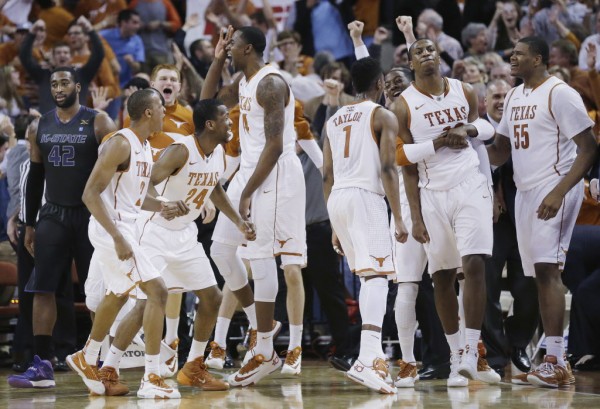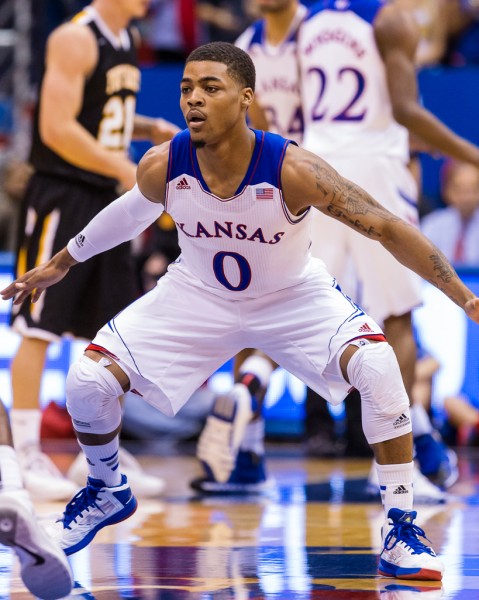Matchup Analysis: Is Texas Built to End Kansas’ Big 12 Dominion?
Posted by Brian Goodman on November 6th, 2014It’s been 10 long years, but the prominent question in the Big 12 remains the same: Will someone throw Kansas from the mountain top? There have been some fantastic runners-up in the Big 12 over the years and four teams have shared the regular season crown with the Jayhawks, so even if the streak isn’t quite as dominant as it appears, it is still incredible. Impressive as it is, though, consistency can be boring, too. With that in mind, it’s natural to identify the next-best team in the conference at the beginning of the season and ask the question of whether this is the year it can rise to the occasion.

Texas was picked second in the Big 12, but are they built to be the team that dethrones Kansas? (AP Photo/Eric Gay)
This season, it’s clear that Texas (on paper) is the second-best team in the conference. You probably know their story, but if you aren’t familiar, the Longhorns return nearly everyone from the campaign that saved Rick Barnes’ job and they fortified a strength with the addition of super-recruit Myles Turner. While rankings aren’t everything, Texas sits at #10 in both the AP and USA Today polls and appears to be about as good as any preseason number two the Big 12 has had over the years. With a double-round robin format in this league, the fate of the conference championship could come down to the head-t0-head battles (January 24 and February 28) between Texas and Kansas, so let’s take a look at those match-ups. To be clear, no team is built with the singular goal of beating another specific team, and any of a number of things could happen that would render this post meaningless, but the possibility is still worth exploring.
From Texas’ perspective, the biggest issue is that the Longhorns aren’t built to exploit Kansas’ biggest perceived weakness, which is guard play. Conner Frankamp’s transfer thinned out the Jayhawks’ guard rotation, which now consists of Wayne Selden and the unproven pair of Frank Mason and Devonte Graham. Texas, on the other hand, has a deep stable of guards who weren’t very productive last year. Kendal Yancy and Isaiah Taylor were the only perimeter players to shoot better than 40 percent from the field, and at the point, Cousins’ 1.7-to-1 assist-to-turnover ratio was nothing to write home about even as Cameron Ridley emerged as a target down low. On top of that, while Demarcus Holland wasn’t the primary ball handler, his turnover rate was a sky-high 23.3 percent. Among Big 12 guards who played at least 40 percent of their team’s minutes, only Naadir Tharpe and Gary Franklin posted worse percentages.
But there’s a lot of potential there, too. Even if Mason and Graham step up and Selden improves with a surgically-repaired knee, Texas has a lot of room to improve too. Everyone who played in the Longhorns’ backcourt last season was either a freshman or a sophomore. The ball-handling struggles are an issue, but Texas can also get better if it simply steps up its three-point accuracy from last season’s 30.3 percent clip, which was eighth in the league. Better years beyond the arc from Holland, Damarcus Croaker and Javan Felix will go a long way, not just for their own purposes, but they’ll also help open up lanes that can be used to deliver the ball to Turner and Ridley.
On the wing, Texas is hoping that Jonathan Holmes will bring senior leadership in addition to improvement on his breakout campaign. Last year, Holmes shot 50.8 percent from the floor, 33.3 percent from three-point range and improved his free throw shooting from 15.5 percent. That will definitely play, and he was the team’s leading rebounder as well, hauling in 7.2 boards per contest. At 6’8″ and 240 pounds, there are many ways that Barnes can use his team’s best player, and Holmes will need to be effective in his final go-round. Bill Self will combat him with an athletic, aggressive high-ceiling wing in Kelly Oubre. Oubre has some potential as a shooter, but at just a slight 200 pounds, it could be tough for him to finish through contact despite his explosiveness.
Down low is where Texas should have an advantage with the big-bodied Ridley and Turner and an extra man in Prince Ibeh available to defend Cliff Alexander, Perry Ellis and Jamari Traylor. There have even been whispers of Texas going zone at times with Holmes and Turner on the wings and Ridley in the middle. That may be a possibility, but Barnes fielded one of the country’s best two-point defenses last year and has essentially everyone back, so while a zone could be effective, it wouldn’t necessarily make them better. Still, since we’re talking about head-to-head-matchups, a zone could help contain a more aggressive Selden, limit Oubre’s ability to drive the ball, or allow the Longhorns to collapse on Alexander if Kansas’ perimeter threats don’t keep defenses honest. If Kansas rediscovers its stroke, however, the Longhorns could be in for a couple of long nights.
I’ll freely admit that looking at games scheduled for late January and the last day of February could be an exercise in futility. I’ll even say there’s a pretty good chance it is – after all, how many times have we seen a talented non-Kansas team at the top of the Big 12 fade to the middle of the pack, allowing the Jayhawks to cruise — but since the question of who can make history and stop Kansas comes up every single November, it’s worth it to entertain the best possible answer with some foresight.












































